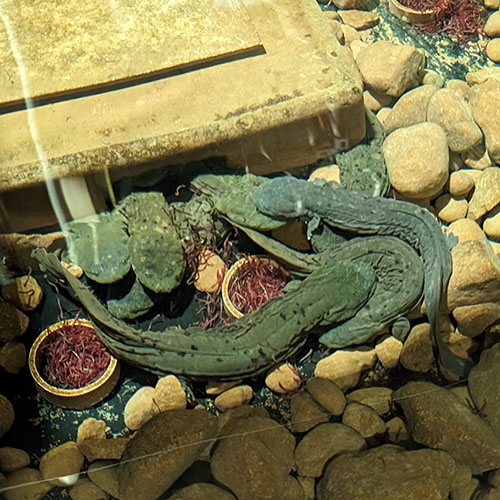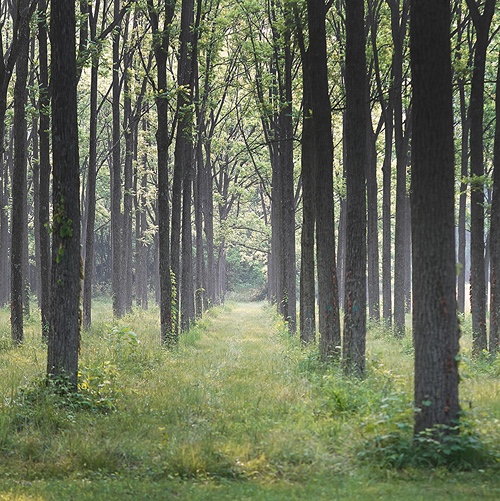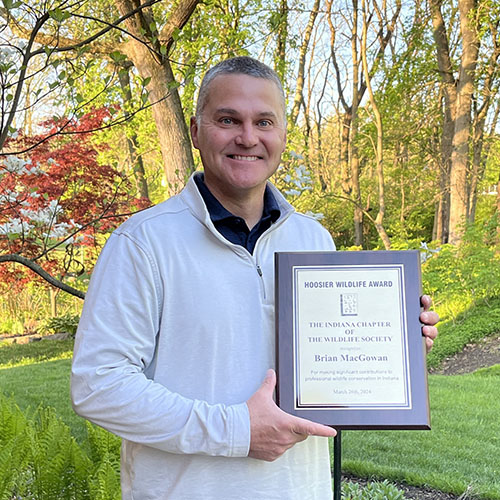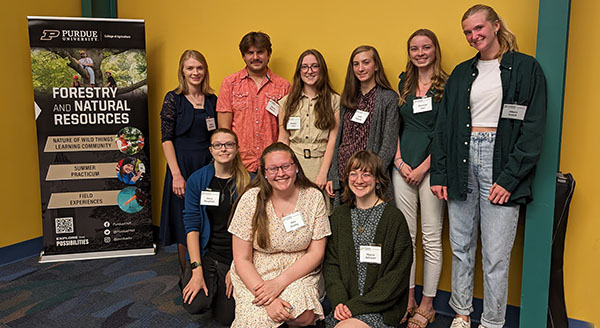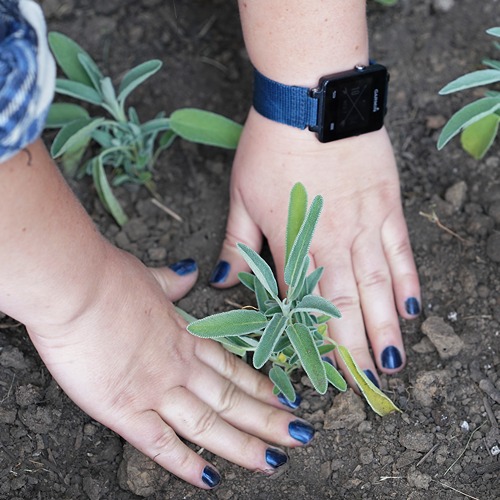“You don’t have to be a superhero to make an impact.” – Trent Osmon, 2023 FNR Distinguished Alumnus Award honoree, BS Forestry 1999.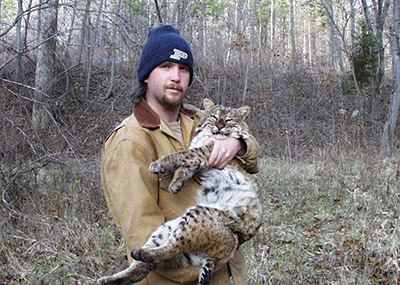
Trent Osmon grew up in Odon, Indiana, just 40 minutes south of Indiana University, where he enrolled in the outdoor recreation management program after high school. It was time spent a few hours further north, however, that helped shape his future before bringing him back home for a career in natural resources.
“I just wanted to be outdoors, I always knew that,” Osmon said. “Sometime during my freshman year, I wrote a paper about where I was going to be in 15 or 20 years. I said I wanted to be the manager of Brown County State Park, one of the largest forests in the state. At the time, I didn’t know a whole lot about forestry. It was my pursuit of finding out how to manage the forest and resources that led me to the understanding that the program that I was in was actually for management of the people at a state or city park as opposed to the scientific resource management of trees and the wildlife within it. It was that realization that made me want to come to Purdue to study the science of the forest.”
Looking back, Osmon, who grew up on a farm and enjoyed hiking and playing in the woods, says he knew from the moment he arrived at Purdue, it was the right move for him to transfer.
“Knowing that I wanted to learn the science, the biology and the management of trees rather than the management of the people, I took a college day up to Purdue,” Osmon recalled. “It was an amazing visit. Even the folks in Hovde Hall that weren’t associated directly with Forestry and Natural Resources were warm and welcoming, and then once I got to meet Dr. W.L. Mills and some of the professors, I just remember loving it and thinking, ‘man, this is the place for me.’ I applied and was accepted and the rest is history.”
Osmon found his footing quickly and got a head start toward his career as part of the co-op program, which allowed students to alternate semesters in the field and in the classroom. He worked 40 hours a week in the public works division at the Naval Surface Warfare Center, Crane Division in southern Indiana for three years. Beginning in the summer of 1997 Osmon gained hands-on training in forest management, environmental assessments, and more en route to receiving his bachelor’s degree in forestry in 1999.
“They understood that I had some unique situations and worked with me,” Osmon explained. “I spent the summer of 1997 and spring of 1998 at Crane, so I missed out on taking forest mensuration, but Dr. Mills let me go on to Summer Camp in 1998 because of my experience in the field down at Crane. There are many other examples and I could go on and on about how tight the family atmosphere was in FNR and that is why I loved it so much. The co-op program helped me tremendously and was worth it for me from a career perspective even though I didn’t graduate with the same class I came in with. The school really worked with outside industry to get us involved with extreme hands-on experience that dovetailed perfectly with our education. Whenever I was in class, I was able to speak with experience from the field as opposed to just lab experience or book experience. It's so hard to replicate what types of things you're going to come across in the field in short lab periods a couple of times a week. There’s nothing that beats being on your own in the field. With the co-op, because it was every other semester, it really was like learn, go apply and come back and learn more about it back on campus.”
While many professors and experiences made an impact on him, a few stand out in Osmon’s mind.
“I always knew I wanted to be outdoors, but Purdue FNR was where I realized who I was,” Osmon said. “Purdue holds an extremely special place in my heart and is one of the most important pieces of my life in terms of education and experience, and it got me to where I am now.
“As for the professors, Dr. Mills showed his faith in me as a young student and impacted me through his mentoring and his advising. Dr. John Moser also was someone that I really respected. Oftentimes foresters are looked at as this blue-collar group that just puts paint on trees. I always loved Dr. Moser’s classes because he showed the calculus and the quantitative analysis, the math and science behind forestry. I also went on two study abroad trips with Dr. Barny Dunning, first to Colorado with Dr. Knudson in 1998 and then to Sweden in 1999, both of which were really fascinating.”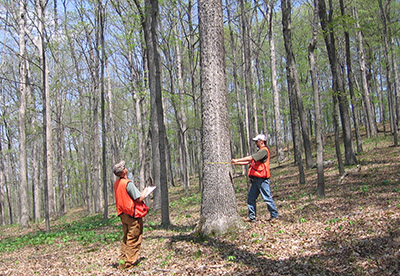
After graduation in 1999, Osmon stepped right into a full-time position as a forester at Crane, a position he held until 2010, when he was promoted to the Forestry Program Lead. As fate would have it, he soon became a collaborator with one of his professors.
“When I was down at Crane shortly after I got a full-time job, we were undergoing one of the 10-year plan revisions, which required a big forest inventory,” Osmon said. “I went back up to Purdue and had a meeting with Dr. Moser and Terry Hobson, my then-boss at Crane, on a professional level about developing the inventory, the plot, the random sampling, where we needed to go mixed hardwoods versus all the different strata. It was really neat to turn around immediately and have one of my professors as a peer to a certain degree. We hired him to develop a lot of our inventory.”
As a forester at Crane, Osmon was involved in every aspect of managing the more than 63,000 total acres of forest on the Crane installation, including 52,000 acres of productive forestland which consists of white oak, black oak, hickory, tulip poplar, black walnut and black cherry among other species.
“I've been at Crane for 26 years plus now,” Osmon said. “That summer of 1997 as a student, I marked some timber and now I can go back and see the sizable trees. To be a part of a process cradle to grave, for a personality like me that wants to get their hands dirty and jump in and act and do, it's been perfect. I was perfectly fit for the forestry and natural resources world working at Crane where they threw me into the woods almost immediately, getting stuff done. The other aspect I love about forestry, especially in the context of working on this Navy installation in Southern Indiana, is that so many of my peers that were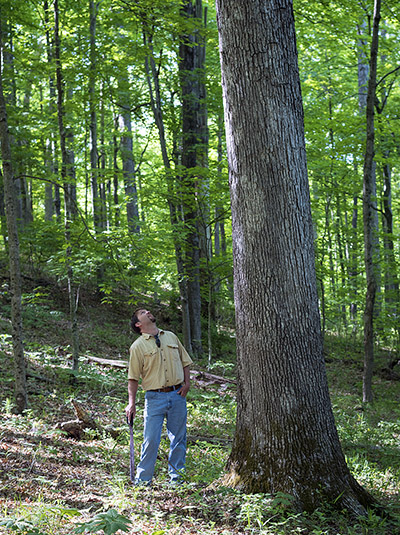 engineers worked on a small component of a component of another component that was then shipped off to the coast and installed on a ship, and they never got to see the completed product. Whereas, as a forester, I was part of the data gathering that then helped conceptualize and finalize the plan, then I got to go into the stand, mark the trees, and utilize my knowledge of wildlife, forestry, hydrology, endangered species and cultural resources and see it all unfold before my very eyes.”
engineers worked on a small component of a component of another component that was then shipped off to the coast and installed on a ship, and they never got to see the completed product. Whereas, as a forester, I was part of the data gathering that then helped conceptualize and finalize the plan, then I got to go into the stand, mark the trees, and utilize my knowledge of wildlife, forestry, hydrology, endangered species and cultural resources and see it all unfold before my very eyes.”
In 2010, when Hobson (Forestry 1978) retired, Osmon stepped into the role of Forestry Program Team Lead, which he served in for the next eight years.
“Trent was always an energetic self-starter, eager to take on new tasks and challenges,” Hobson said. “He was always a reliable member of our working group and naturally I wanted him to continue on as a permanent member of our team (after his graduation). He always thought outside the box in order to find better ways to accomplish program goals. Trent also has an engaging personality that inspires buy-in from other team members. He displays confidence and intelligence and I believe he is naturally perceived as a leader. I knew he would move the natural resources/environmental program at Crane forward after I retired, and he has.”
For Osmon, transitioning from forester to team lead brought new perspective.
“As a team lead, I started to diminish my field time a little bit because I began helping arrange budgetary items and doing long-range planning,” Osmon recalled. “But, when I was forced to sit behind a desk, it helped open my eyes to the tremendous benefit that timber harvesting can have. You get to see the numbers before you from a little greater distance and see the impacts beyond the forestry world. We can have a broader reach than just the little sphere that we’re in when we walk through the woods.
“We were growing easily 10-11 million board feet of timber per year and we were only harvesting about 3-4 million board feet per year (or 1500 acres of timber). We have a sustainable program. Harvesting at that level was funding all of the service contracts, the invasive species treatments, and the salaries of all of the individuals that were working in the program. It also was helping other forestry and natural resource programs throughout the Navy from long-leaf pine restoration in the southeastern United States to some of the fire ecology work that greatly benefits the red cockaded woodpecker and more.”
One of the most high profile projects Osmon and his colleagues have been involved with is tending to Constitution Grove, a stand of white oak trees grown and reserved for use on the restoration of the U.S.S. Constitution. The efforts began in 1976 with the ship’s bicentennial renovation and the dedication of the grove. In July 1997, Old Ironsides was able to sail under its own power for the first time in over 100 years after Crane foresters, including Hobson, selected and sent 78 trees to Boston, where the logs were milled and made into the ship’s 40-foot planks and tall masts. Osmon just missed that harvest, but was ready for his contributions in 2012 when the next call came.
“Terry showed me all of the photos he took when he had driven out to Boston during the restoration and I thought it was the coolest thing in the world,” Osmon said. “I remember thinking at that point, man, the next time they restore it, in 20 years or so, I want to be a part of it. We sent 25 trees in 2015, four more in January of this year and we will be sending 10 more this next harvesting season. It is a very small portion of what we do, but it is the coolest, especially if you ask anyone in the Navy.”
In 2018, Osmon became the Environmental Division Supervisor on the naval installation, managing environmental compliance programs from drinking water and groundwater monitoring to natural resources and cultural resources management.
“I oversee a much broader installation compliance program than just the forestry and natural resources, from the cultural resources piece to drinking water and waste water programs, fuel tanks above and below ground, solid waste, and the cleanup of past contamination on the site,” Osmon explained. “But I’ve always thought what Terry Hobson said was true, that forestry is a fantastic, broad-based land management degree that is all encompassing. The chemistry, the ecology, the biology, the mensuration, the forest measurement, the math and everything else within the forestry program equips you to be an overall landscape manager. I think that still plays out for me.
“Without even thinking oftentimes in my day-to-day job, I am pulling upon that knowledge that I learned in the forestry curriculum and how it taught me to look at the world. That mindset has taught me to look at things and learn in a specific way that has helped me tremendously. A good example is our drinking water system at Crane, it pulls from an 800-acre surface water lake, which is 100 percent forested watershed. The fact that the forest and vegetation and buffers play such a key role in making that water so much cleaner is something that I learned in the forestry world. Similar situations apply in the ecology of cleaning up past contamination and using my knowledge of ecology, plants, mammals, dendrology and bioaccumulation.”
Osmon is surrounded by Purdue FNR graduates in the natural resources area at Crane. Brady Miller (Wildlife 2001, Forestry 2003) is now the Natural Resources Manager on base, while Rhett Steele (Forestry 2001) is the forestry program lead. Rob McGriff (Forestry 1990) joined the staff as a forester in 2019.
(Wildlife 2001, Forestry 2003) is now the Natural Resources Manager on base, while Rhett Steele (Forestry 2001) is the forestry program lead. Rob McGriff (Forestry 1990) joined the staff as a forester in 2019.
The group lends their expertise to the Navy for daily duties ranging from arborist to surveyor and everything in between, but sometimes their impact is more visible to those on base.
“The benefits of the forestry program on the installation are a little more indirect on a day-to-day basis until our expertise is called upon to clear land for a mission operation range, etc.,” Osmon said. “We jump at those types of opportunities whenever we can to serve the country. It’s kind of a dream job, being able to wander out in the woods and benefit these type of mission projects directly. In this case, I was able to take the ArcView mapping program and make an image of the landscape and lay out the area of trees that needed to be cleared. Then Rhett, Brady and I went out and did a survey. It felt like we were back in summer camp with our compasses and azimuths as we headed out and marked the timber boundary. And now, it’s a range supporting mission operations.
“The Navy also sees us as the hardwood tree experts. Crane is known far and wide for its sustainable forest management. They are taking the things we have learned about and techniques we are employing and are applying them across the Navy. In terms of financial impact, the actions of our two field foresters and the 3-4 million board feet we harvest each year puts upwards of $150 million into the local economy. That is a huge honor right there. My point is that it isn’t hard to make a big impact; it doesn’t take a superhero to make an impact.”
Another role Osmon and his colleagues fill is facilitating the many research projects that take place on base, ranging from plant and animal surveys to work on PFAS (per- and polyfluoroalkyl substances or forever chemicals) and remote sensing.
ranging from plant and animal surveys to work on PFAS (per- and polyfluoroalkyl substances or forever chemicals) and remote sensing.
“It’s important to me to make Crane as much of a lab space as possible,” Osmon said. “In my position as environmental director, I have the unique ability to reach out to the agencies that fund a lot of the research. Through the Cooperative Ecologic Study Units (CESU) program, we have been able to secure funding for additional studies on the installation, including Dr. Mike Saunders’ work on various oak regeneration methods or Dr. Songlin Fei’s remote sensing work with unmanned aerial systems. We have had researchers from several universities - Purdue, Indiana State, Ball State, Oregon State - on the installation and I hope to continue that. The benefit of the research to the natural resource and mankind in general is an honor to be a part of and makes the work worthwhile.”
The Purdue Forestry and Natural Resources Distinguished Alumnus Award recognizes alumni for demonstrating a record of outstanding accomplishments, having made significant contributions to his/her profession or society in general and exhibiting high potential for future professional growth.
Osmon has not only made significant contributions professionally, but personally as a member of the pediatric cancer community, beginning in 2013 when his youngest son was diagnosed with leukemia. Over the years, Trent and his wife Karrie have raised tens of thousands of dollars for cancer research at Riley’s Children’s Hospital and have become central figures in the cancer community throughout their son’s journey through four diagnoses to his eventual remission in 2020.
“Trent has long been an educator and advocate for other families going through their pediatric cancer journey,” Karrie shared. “He has reached out countless times, been a sounding board, or a support to those families while they were dealing with their own diagnosis. He also has spoken on behalf of our family numerous times to help raise funds. His roots from Purdue University and Forestry and Natural Resources have made him conscious of the world around him, willing to help those in the community and be a successful provider and father.”
Dr. Mike Saunders, who nominated Osmon for the Distinguished Alumnus Award, elaborated on his qualifications for the honor.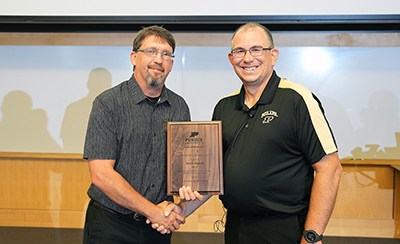
“Trent embodies the hope that I have for every FNR alum – that one is impactful and successful not only in their career but also in their community,” Saunders said. “Trent’s impact has been felt nationally both in his profession and in the cancer community. He is a role model for our students for his outstanding years of work at Crane and across the U.S. Navy, for his support of numerous research projects on the base, for his contributions to the pediatric cancer and local communities and for being an inspirational father and husband.”
Hobson summed it up best, “Trent’s leadership within his family in dealing with his son’s battle with childhood leukemia (which they beat), makes his professional accomplishments seem miniscule.”
